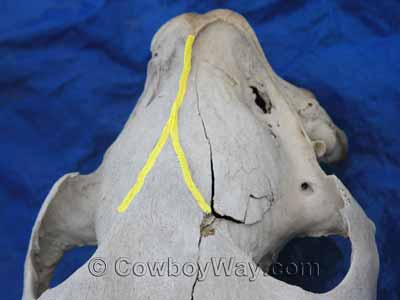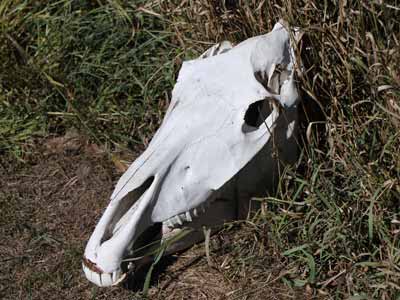How To Tell A Horse Skull From A Cow Skull
Telling a horse skull from a cow skull is easy once you recognize a couple of key differences.
Before we dive in, we'd like to say:
For the purposes of this article when we say "cow" skull we're referring to:
- Domestic cattle (aka Bos taurus). And...
- We're referring to female and male domestic cattle. As you probably know, the word "cow" is correctly used to refer to a mature female of the cattle family. However, we're using it on this page in a more casual manner to refer to cows, bulls, steers, heifers, or oxen.
There are numerous differences between a horse skull and a cow skull. However, we're only going to focus on two easily noticeable distinctions: The teeth, and a bony ridge on the forehead.
So lets get started......
Below: A horse skull on the left, a cow skull on the right.

Horse Skull Vs. Cow Skull: The Teeth Tell A Tale
If there is one, super easy way to tell the difference between a horse skull and a cow skull it would probably be the teeth.
- Horses have upper and lower incisor teeth. If the skull has lost it incisors, the sockets where they used to be will still be visible.
- Cows have lower incisor teeth only.
First, A Look At Horse Teeth
The photo below shows a close-up look of a horse's upper jaw. Notice the incisor teeth.
Below: The top incisor teeth on a horse skull.

Even if a horse skull is missing some, most, or all of its upper incisor teeth you can see the sockets where the teeth used to be.
Below: You can see this horse skull has some of its upper incisor teeth, but others have fallen out. Even so, you can clearly see where the missing teeth used to be.

Next, A Look At A Cow's Dental Pad
The photo below shows a close-up look of a cow's upper jaw. Instead of upper incisor teeth, you can see there is a "dental pad" (also called a "browsing pad").
Below: The dental pad on a cow skull. Cows have dental pads on the upper jaw instead of incisor teeth.

Below: A cow's dental pad viewed from the side. Not only are there not any teeth, there aren't any sockets where teeth would have been.

Note: While cattle don't have upper incisor teeth, they do have lower incisor teeth.
Cattle's lower incisor teeth are frequently used to estimate their age.
Horse Skull Vs. Cow Skull: The Forehead
The forehead of a horse skull and cow skull look very different.
- A horse's forehead is narrower than a cow's, and the sides slope downward from a bony ridge in the middle that looks like an upside down "Y."
- A cow's forehead is broader and flatter than a horse's, and does not have a bony ridge.
First, A Look At A Horse's Forehead
A horse's forehead is narrower than a cow's, and the sides slope downward from a bony ridge in the middle that looks like an upside down "Y."
Below: A horse skull showing the bony ridge on the forehead that looks like an upside down "Y." Each side of the forehead slopes downward from there.

Below: The same horse skull as above, only with yellow highlighting.

Next, A Look At A Cow's Forehead
A cow's forehead is broader and flatter than a horse's without a bony ridge.
Below: A cow skull. Compared to a horse it is broader, flatter, and doesn't have a bony ridge.

One More Horse Skull / Cow Skull Comparison
Here are a couple of more horse skull / cow skull photos. This time, the photos show the full length of the skulls instead of being close-ups.
Below: A horse skull. Notice the bony ridge on the forehead and the upper incisor teeth.

Below: A cow skull. The forehead is broader, wider, and flatter than a horse skull, and does not have a bony ridge. Also, the upper jaw has a dental pad instead of incisor teeth.

Horse and Cow Skulls: A Few Pieces Of Trivia
Like we mentioned at the beginning of this article there are numerous differences between horse and cow skulls. Yet, we've only mentioned two of them. That's because we decided to focus on two obvious differences that are easy to recognize at a glance.
However, there are several pieces of related trivia that we think are interesting and we'd like to mention them:
- Adult horses have 6 upper, and 6 lower, incisor teeth.
- Adult cows have 8 lower incisor teeth.
- Both horses and cows have molar teeth.
- About that bony ridge on a horse's forehead: The top part (the stem of the upside down "Y") is called the "sagittal crest." The branches of the "Y" are called the "temporal lines."
- About a cow's dental pad: Cow's aren't the only ones that have it. Other ruminants have dental pads too, including sheep, goats, deer, giraffes, and more.
How To...
… Care For Your Felt Cowboy Hat
… Care For Your Saddle Pad Or Blanket
… Close A Gate With A Chain Latch
… Estimate Cattle Age By Their Teeth
… Fishtail Braid Your Horse's Tail
… Make A Bridle Rack Out Of Tin Cans
… Make A Collapsible Wood Saddle Rack
… Make A Flag Boot Out Of A Horn
… Make Homemade Hoof Conditioner
… Make Homemade Horse Fly Spray
… Measure A Western Saddle Seat
… Put A Horn Knot On Your Rope
… Put A Speed Burner On A Honda
… Recognize Common Horse Colors
… Recognize Common Horse Face Markings
… Stop A Saddle From Squeaking
… Tell A Boy Cow From A Girl Cow
… Tell A Horse Skull From A Cow Skull
… Tie A Stopper Knot
Tie a stopper knot for the end of a rope, or a metal, rawhide, or plastic honda
… Tie A Stopper Knot For A Honda
Tie a stopper knot for a tied honda
… Understand Leather / Hide Thickness
… Weigh A Horse and Optimize Rider Weight
… Wrap A Saddle Horn With Rubber
You Might Also Like...
